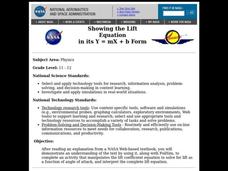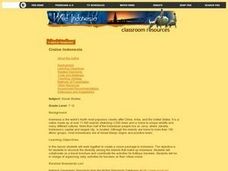Curated OER
Actual Airflow vs. Ideal Airflow: Stalls
Students use 3-D modeling techniques to observe the characteristic signature of the stall condition apparent on an airfoil at high angles of attack. They use FoilSim to compare the above with ideal airflow.
Curated OER
Using Graphs to Compare
Students use the FoilSim computer simulation program, and demonstrate an understanding of the lift variables by explaining their graphical representations. They demonstrate an understanding of forces and motion.
Curated OER
Tessel Your Way to Nagano!: Olympics, Winter Sports, Snowboarding, Graphic Design, Geometry, Math, M.C. Escher, Tessellations
Students create Post-It note fundamental regions to tesselate. They make tesselations using computer software or websites. They create a jacket design with tesselation and determine the cost of production.
Curated OER
Wind Gauges
Students use FoilSim interactive software to become familiar with the way in which the flow of air across or around an airfoil affects its ability to create lift.
Curated OER
Did You Catch My Drift?
Students, through the use of the Curveball interactive software package, become familiar with the way in which the flow of air across or around an object affects its ability to lift, spin, and curve. After reading the explanation given...
Curated OER
Showing the Lift Equation
Pupils read an explanation from a NASA Web-based textbook, then demonstrate an understanding of the text by using it, along with FoilSim, to complete an activity that manipulates the lift coefficient equation.
Curated OER
Lift Equation Problem Set
Students, after reading an explanation from a NASA Web-based textbook, demonstrate an understanding of the text by using it, along with FoilSim, to complete an activity to graph and interpret the lift equation.
Curated OER
Pharaoh Phonetics
Students explore ancient Egypt. In this Egypt lesson plan, students use the Internet to research ancient Egypt and then participate in several activities that help them better understand Egyptian culture.
Curated OER
Upside-Down Wings
Students use FoilSim to demonstrate that the graphic analysis of the airflow around one object can be used to hypothesize airflow graphs for objects as they are elongated from a sphere to an airfoil shape.
Curated OER
Design of Airfoil for Given Lift
Pupils use FoilSim to design an airplane wing that generates a given lift. As they change parameters such as airspeed, altitude, angle of attack, thickness and curvature of the airfoil, and size of the wing area, the software calculates...
Curated OER
Lift Relationships
Students use FoilSim (downloadable) to determine how lift is affected by varying parameters on the Airfoil simulation.
Curated OER
Cruise Indonesia
Students work together to create a cruise package to Indonesia. They collaborate on a travel brochure and coordinate daily activities for fictitious travelers to discover the diversity among the islands that make up Indonesia.
Curated OER
Numbers System Conversions
In this number system conversions activity, students explore, analyze and develop mastery skills in converting between alternative number systems.
Curated OER
Wing Shapes and Areas
Students, after reading the explanation given below, use FoilSim to determine the weight of the aircraft that can be lifted by a pair of wings of each type. They also design a unique platform of a wing to lift a plane weighing 11500 pounds.
Curated OER
Temperature and Altitude
Learners, after reading the explanation given below, use FoilSim to gather and record data on temperature and altitude generated by the FoilSim control panel.
Curated OER
Wing Area Effects Problem Set
Students read an explanation from a NASA Web-based textbook on lift and an explanation on the FoilSim software package given below. They use FoilSim to evaluate the relationship between wing area and lift.
Curated OER
Velocity Effects Problem Set
Students, after reading an explanation on lift from a NASA Web-based textbook and an explanation on the FoilSim software package given below, use FoilSim to evaluate the relationship between velocity and lift.
Curated OER
The Baseball and Air
Learners use Curveball to complete the activity to determine how the speed of airstreams changes in relation to changes in the distance of the airstream from the center of the baseball.
Curated OER
Lift vs. Airspeed
Students, after reading the explanation given below, use FoilSim and a graphing calculator to complete the activity to determine the relationship between airspeed and lift of an object by interpreting data.
Curated OER
Design of Airfoils and Problem- Solving Using FoilSim
Ninth graders, after reading the explanation given below, complete the problem-solving activities to demonstrate an understanding of the concepts presented.
Curated OER
Characteristics of Lift and Wing Area
Students use FoilSim to complete the activity and investigate the factors that affect lift and how wing area and lift are related.
Curated OER
Wing Specifications
Ninth graders use FoilSim to fulfill the specifications of a given airfoil (wing) and plot and interpret graphs.
























